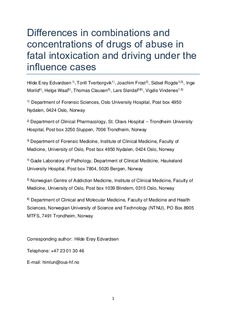| dc.contributor.author | Edvardsen, Hilde Marie Erøy | |
| dc.contributor.author | Tverborgvik, Torill | |
| dc.contributor.author | Frost, Joachim | |
| dc.contributor.author | Rogde, Sidsel | |
| dc.contributor.author | Morild, Inge | |
| dc.contributor.author | Waal, Helge | |
| dc.contributor.author | Clausen, Thomas | |
| dc.contributor.author | Slørdal, Lars | |
| dc.contributor.author | Vindenes, Vigdis | |
| dc.date.accessioned | 2018-02-23T11:38:19Z | |
| dc.date.available | 2018-02-23T11:38:19Z | |
| dc.date.created | 2017-12-15T13:52:25Z | |
| dc.date.issued | 2017 | |
| dc.identifier.citation | Forensic Science International. 2017, 281 127-133. | nb_NO |
| dc.identifier.issn | 0379-0738 | |
| dc.identifier.uri | http://hdl.handle.net/11250/2486716 | |
| dc.description.abstract | Background
In toxicology, international classification systems focus on single intoxicants as the cause of death. It is, however, well known that very few drug related deaths are caused by a single substance and that information concerning the drug concentrations as well as the combinations of drugs are essential in order to ascertain the cause of death. The aim of the study was to assess whether those prone to fatal intoxications differ significantly from chronic drug users – in terms of demographics and drug exposure patterns.
Material and methods
Fatal psychoactive drug intoxications in Norway during 2012, where a forensic autopsy including toxicological analysis were performed, were included. Analytical findings in blood were compared with concentrations in blood from apprehended drivers under the influence of drugs and ethanol (DUID) during the same time period. The opioid and benzodiazepine concentrations were assessed as morphine and diazepam equivalents, respectively, in order to compare concentrations across the different groups.
Results
A total of 194 autopsy cases and 4811 DUID cases were included. Opioids were detected in around 90% of the drug intoxication cases, but in only 16% of the DUID cases. The number of substances detected in fatal intoxications was 4.9 compared to 2.6 in the DUID cases. The total opioid concentrations were significantly higher in the fatal intoxication cases compared to DUID cases (229 ng/mL versus 56.9 ng/mL morphine equivalents, respectively). Benzodiazepines were detected in 90% of the fatal cases. Only one fatal opioid mono-intoxication was found; a case with a very high methadone concentration (1238 ng/mL).
Discussion
Mono-intoxication with heroin was not seen in any of the fatal intoxications in Norway, and single drug intoxications were rare (1.5%). Fatal intoxications were caused by a combination of drugs with significantly more substances as well as higher total drug concentrations among the fatal cases compared to the DUID cases. The combination of opioids and benzodiazepines seemed to represent an increased risk of death.
Conclusion
The total load of drugs influence the degree of intoxication and the total concentration level must be considered, including the total number of substances. Our findings imply that international statistics regarding an opioid being the main intoxicant should have a shift in focus towards combinations of drugs (especially opioids and benzodiazepines) as a major risk factor for fatal drug overdoses. | nb_NO |
| dc.language.iso | eng | nb_NO |
| dc.publisher | Elsevier | nb_NO |
| dc.rights | Attribution-NonCommercial-NoDerivatives 4.0 Internasjonal | * |
| dc.rights.uri | http://creativecommons.org/licenses/by-nc-nd/4.0/deed.no | * |
| dc.title | Differences in combinations and concentrations of drugs of abuse in fatal intoxication and driving under the influence cases | nb_NO |
| dc.type | Journal article | nb_NO |
| dc.type | Peer reviewed | nb_NO |
| dc.description.version | acceptedVersion | nb_NO |
| dc.source.pagenumber | 127-133 | nb_NO |
| dc.source.volume | 281 | nb_NO |
| dc.source.journal | Forensic Science International | nb_NO |
| dc.identifier.doi | 10.1016/j.forsciint.2017.10.045 | |
| dc.identifier.cristin | 1528077 | |
| dc.description.localcode | © 2017. This is the authors’ accepted and refereed manuscript to the article. Locked until 6.11.2018 due to copyright restrictions. This manuscript version is made available under the CC-BY-NC-ND 4.0 license http://creativecommons.org/licenses/by-nc-nd/4.0/ | nb_NO |
| cristin.unitcode | 194,65,15,0 | |
| cristin.unitname | Institutt for klinisk og molekylær medisin | |
| cristin.ispublished | true | |
| cristin.fulltext | postprint | |
| cristin.qualitycode | 1 | |

